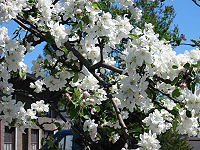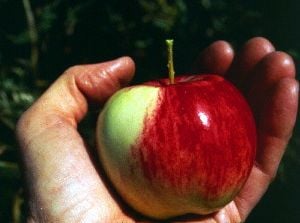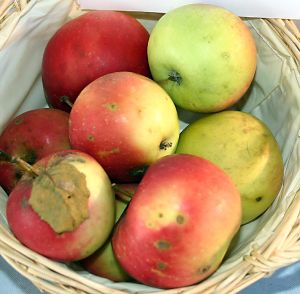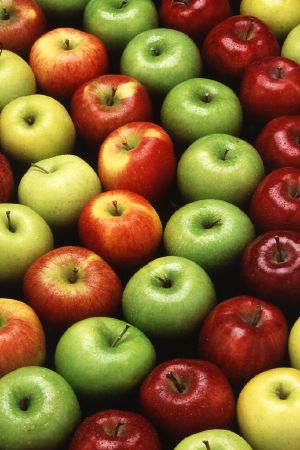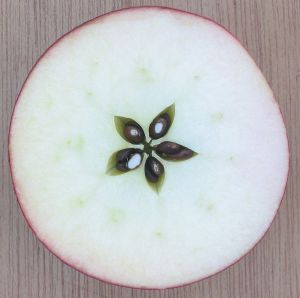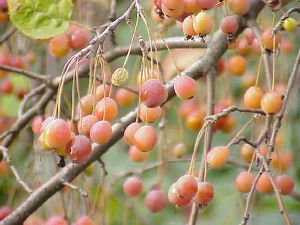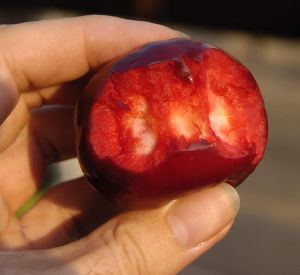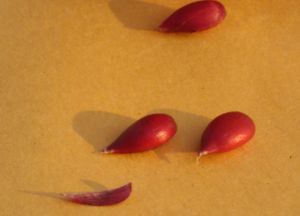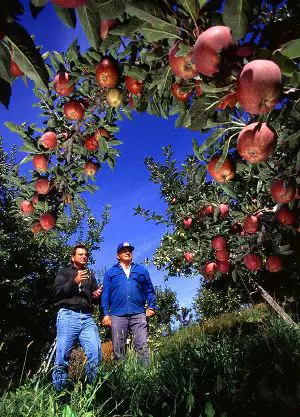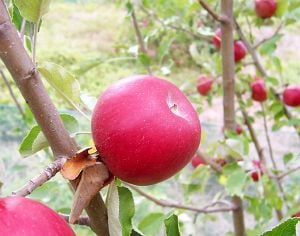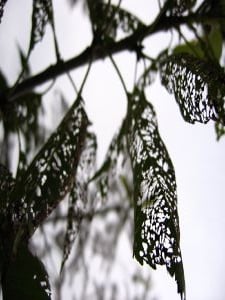Difference between revisions of "Apple" - New World Encyclopedia
Rick Swarts (talk | contribs) |
m (Robot: Remove contracted tag) |
||
| (15 intermediate revisions by 4 users not shown) | |||
| Line 1: | Line 1: | ||
| − | {{ | + | {{Copyedited}}{{Paid}}{{Approved}}{{Images OK}}{{Submitted}} |
| − | {{ | + | [[Category:Public]] |
{{Taxobox_begin | color = lightgreen | name = Apple}} | {{Taxobox_begin | color = lightgreen | name = Apple}} | ||
{{Taxobox_image | image = [[Image:Koeh-108.jpg|240px|Fuji apple]] | caption = Apple tree (''Malus domestica'')}} | {{Taxobox_image | image = [[Image:Koeh-108.jpg|240px|Fuji apple]] | caption = Apple tree (''Malus domestica'')}} | ||
| Line 7: | Line 7: | ||
{{Taxobox_divisio_entry | taxon = [[Flowering plant|Magnoliophyta]]}} | {{Taxobox_divisio_entry | taxon = [[Flowering plant|Magnoliophyta]]}} | ||
{{Taxobox_classis_entry | taxon = [[Dicotyledon|Magnoliopsida]]}} | {{Taxobox_classis_entry | taxon = [[Dicotyledon|Magnoliopsida]]}} | ||
| − | {{Taxobox_ordo_entry | taxon = Rosales}} | + | {{Taxobox_ordo_entry | taxon = [[Rosales]]}} |
| − | {{Taxobox_familia_entry | taxon = Rosaceae}} | + | {{Taxobox_familia_entry | taxon = [[Rosaceae]]}} |
{{Taxobox_subfamilia_entry | taxon = Maloideae}} | {{Taxobox_subfamilia_entry | taxon = Maloideae}} | ||
{{Taxobox_genus_entry | taxon = ''Malus''}} | {{Taxobox_genus_entry | taxon = ''Malus''}} | ||
| Line 17: | Line 17: | ||
| − | The '''apple''' is a genus (''Malus'') of about | + | The '''apple''' is a genus (''Malus'') of about 30–35 [[species]] of small deciduous [[tree]]s or shrubs in the [[flowering plant]] family ''Rosaceae.'' The term also refers to the [[fruit]] of these trees, and in particular the fruit of the [[species]] ''Malus domestica,'' the domesticated orchard or table apple. This is one of the most widely cultivated tree fruits. The other species are generally known as "wild apples," "crab apples," "crabapples," or "crabs," this name being derived from their generally small and sour, unpalatable fruit. The genus is native to the temperate zone of the Northern Hemisphere, in [[Europe]], [[Asia]], and [[North America]]. |
| − | Malus species, | + | Malus species and their fruit offer many nutritional, [[ecology|ecological]], and aesthetic values—providing health benefits for [[human]]s, a home for many species, and pleasures of taste and sight. Through their harmonious relationship with pollinating insects, apple trees can produce fruit and reproduce, while providing nectar in exchange. The domestic apple also serves symbolic value in works of art and various legends and traditions. In the [[Christianity|Christian]] tradition, it is the apple that is often depicted as the forbidden fruit at the center of the Genesis account of the fall of [[Adam and Eve]]. |
| − | + | Malus species, including domestic apples, hybridize freely. The trees are used as food plants by the larvae of a large number of Lepidoptera species. The fruit is a globose pome, varying in size from 1–4 cm diameter in most of the wild species, to 6 cm in ''M. pumila,'' 8 cm in ''M. sieversii,'' and even larger in cultivated orchard apples. The center of the fruit contains five carpels arranged star-like, each containing one to two (rarely three) [[seed]]s. | |
| − | ''Malus | + | One species, ''Malus trilobata,'' from southwest Asia, has three- to seven-lobed [[leaf|leaves]] (superficially resembling a [[maple]] leaf) and with several structural differences in the fruit; it is often treated in a genus of its own, as ''Eriolobus trilobatus.'' |
| + | ''Malus domestica,'' the domesticated orchard apple, is a small tree, generally reaching 5–12 meters in height, with a broad, often densely twiggy crown. Apples require cross-pollination between individuals by [[insect]]s (typically [[bee]]s, which freely visit the [[flower]]s for both nectar and [[pollen]]). | ||
| + | |||
| + | ==Origin of name== | ||
| + | The word '''apple''' comes from the Old English word '''aeppel,''' which in turn has recognizable cognates in a number of the northern branches of the Indo-European language family. The prevailing theory is that "apple" may be one of the most ancient Indo-European words (*''abl-'') to come down to English in a recognizable form. The scientific name ''Malus,'' on the other hand, comes from the Latin word for apple, and ultimately from the archaic Greek ''mālon'' (''mēlon'' in later dialects). The legendary place name Avalon is thought to come from a Celtic evolution of the same root as the English "apple"; the name of the town of Avellino, near Naples in [[Italy]] is likewise thought to come from the same root via the Italic languages. | ||
==''Malus domestica''== | ==''Malus domestica''== | ||
| − | [[Image:appletree_bloom_l.jpg|right|thumb| | + | [[Image:appletree_bloom_l.jpg|right|thumb|200px|Apple tree in flower]] |
| − | The [[leaf|leaves]] of domestic apple trees are alternately arranged, simple oval with an acute tip and serrated margin, slightly downy below, | + | The [[leaf|leaves]] of domestic apple trees are alternately arranged, simple oval with an acute tip and serrated margin, slightly downy below, 5–12 cm long and 3–6 cm broad on a 2–5 cm petiole. |
| − | The [[flower]]s | + | The [[flower]]s, produced in spring with the leaves, are usually white, often tinged with pink at first. The flowers are about 2.5–3.5 cm diameter, with five petals, and with usually red stamens that produce copious [[pollen]], and an inferior ovary. Flowering occurs in the spring after 50–80 growing degree days. All flowers are self-sterile, and self-pollination is impossible, making pollinating [[insect]]s essential. The [[honeybee]] is the most effective pollinator of domestic apples. |
===Botanical origins=== | ===Botanical origins=== | ||
| − | + | The wild ancestor of ''Malus domestica'' is ''Malus sieversii.'' It has no common name in English, but is known where it is native as "alma"; in fact, one major city in the region where it is thought to originate is called Alma-Ata, or "father of the apples." This tree is still found wild in the mountains of Central Asia in southern [[Kazakhstan]], [[Kyrgyzstan]], [[Tajikistan]], and Xinjiang, [[China]]. | |
| − | The wild ancestor of ''Malus domestica'' is ''Malus sieversii'' | ||
| − | + | [[Image:95apple.jpeg|left|thumb|Wild ''Malus sieversii'' apple in Kazakhstan]] | |
| − | + | For many years, there was a debate about whether ''M. domestica'' evolved from chance hybridization among various wild [[species]]. Recent [[DNA]] analysis by Barrie Juniper and others has indicated, however, that the hybridization theory is probably false. Instead, it appears that a single species, which is still growing in the Ili Valley on the northern slopes of the Tien Shan mountains at the border of northwest [[China]] and the former Soviet Republic of Kazakhstan, is the likely progenitor of the apples people eat today. [[Leaf|Leaves]] taken from [[tree]]s in this area were analyzed for DNA composition, which showed them all to belong to the species ''Malus sieversii,'' with some [[gene|genetic sequences]] common to ''M. domestica''. | |
| − | [[ | + | Other species that were previously thought to have made contributions to the [[gene|genome]] of the domestic apples are ''Malus baccata'' and ''Malus sylvestris,'' but there is no hard evidence for this in older apple cultivars. These and other ''Malus'' species have been used in program to develop apples suitable for growing in climates unsuitable for ''M. domestica,'' mainly for increased cold tolerance. |
| − | |||
| − | The | + | The apple tree was probably the earliest tree to be cultivated. |
==Apple cultivars== | ==Apple cultivars== | ||
| − | [[Image:Malus-Jonathan.jpg|thumb|Apples of the cultivar | + | [[Image:Malus-Jonathan.jpg|thumb|Apples of the cultivar “Jonathan”]] |
| − | There are more than 7,500 known cultivars of apples. Different cultivars are available for temperate and subtropical climates. Apples do not flower in tropical climates because they have a chilling requirement. | + | There are more than 7,500 known cultivars of apples. (A cultivar is similar to "variety"; it is a named group of cultivated plants.) Different cultivars are available for temperate and subtropical climates. Apples do not flower in tropical climates because they have a chilling requirement. |
| − | Commercially-popular apple cultivars are soft but crisp. Other desired qualities in modern commercial apple breeding are a colorful skin, absence of russeting, ease of shipping, lengthy storage ability, high yields, disease resistance, typical | + | Commercially-popular apple cultivars are soft, but crisp. Other desired qualities in modern commercial apple breeding are a colorful [[skin]], absence of russeting, ease of shipping, lengthy storage ability, high yields, [[disease]] resistance, typical "Red Delicious" apple shape, long stem (to allow pesticides to penetrate the top of the fruit), and popular flavor. |
| − | Old cultivars are often oddly shaped, russeted, and have a variety of textures and colors. Many of them have excellent flavor (arguably better than commercial apples), but may have other problems | + | Old cultivars are often oddly shaped, russeted, and have a variety of textures and colors. Many of them have excellent flavor (arguably better than more commercial apples), but may have other problems that make them commercially unviable, such as low yield, liability to disease, or poor tolerance for storage or transport. A few old cultivars are still produced on a large scale, but many have been kept alive by home gardeners and farmers that sell directly to local markets. Many unusual and locally important cultivars with their own unique taste and appearance are out there to discover; apple conservation campaigns have sprung up around the world to preserve such local cultivars from [[extinction]]. |
| − | [[Image:Apple blossom.jpg|thumb|Flowers of a | + | [[Image:Apple blossom.jpg|thumb|Flowers of a “Fuji” apple, [[Australia]]]] |
Although most cultivars are bred for eating fresh (dessert apples), some are cultivated specifically for cooking (cooking apples) or producing cider. Cider apples are typically too tart and astringent to eat fresh, but they give the beverage a rich flavor that dessert apples cannot. | Although most cultivars are bred for eating fresh (dessert apples), some are cultivated specifically for cooking (cooking apples) or producing cider. Cider apples are typically too tart and astringent to eat fresh, but they give the beverage a rich flavor that dessert apples cannot. | ||
| − | Modern apples are generally sweeter than older cultivars. Most [[North America]]ns and Europeans | + | Modern apples are generally sweeter than older cultivars. Most [[North America]]ns and Europeans favor sweet, subacid apples, but tart apples have a strong, but reduced following. Extremely sweet apples with barely any acid flavor are popular in [[Asia]] and especially [[India]]. |
| + | |||
| + | Tastes in apples vary from one person to another and have changed over time. As an example, the U.S. state of Washington made its reputation for apple growing on Red Delicious. In recent years, many apple connoisseurs have come to regard the Red Delicious as inferior to cultivars such as Fuji and Gala due to its merely mild flavor and insufficiently firm texture. | ||
| − | + | ==Commerce and uses== | |
| + | [[Image:Apples.jpg|thumb|right|A display of different apples]] | ||
| + | Domestic apples have remained an important food in all cooler climates. To a greater degree than other [[tree]] [[fruit]], except possibly [[citrus]], apples store for months while still retaining much of their nutritive value. Winter apples, picked in late autumn and stored just above freezing, have been an important food in [[Asia]] and [[Europe]] for millennia, as well as in [[Argentina]] and in the [[United States]] since the arrival of Europeans. | ||
| + | |||
| + | In 2002, 45 million tons of apples were grown worldwide, with a value of about 10 billion U.S. dollars. [[China]] produced almost half of this total. Argentina is the second-leading producer, with more than 15 percent of the world production. The United States is third in production, accounting for 7.5 percent of world production. [[Turkey (country)|Turkey]] is also a leading producer. [[France]], [[Italy]], [[South Africa]], and [[Chile]] are among the leading apple exporters. | ||
| + | |||
| + | In the United States, more than 60 percent of all the apples sold commercially are grown in Washington State. Imported apples from [[New Zealand]] and other more temperate areas are increasing each year and competing with U.S. production. | ||
| + | |||
| + | [[Image:Sterappel_dwarsdrsn.jpg|left|thumb|Apple cut horizontally, showing seeds]] | ||
| + | Apples can be canned, juiced, and optionally fermented to produce apple juice, cider, vinegar, and pectin. Distilled apple cider produces the spirits applejack and Calvados. Apple wine can also be made. Apples make a popular lunchbox fruit as well. | ||
| + | |||
| + | Apples are an important ingredient in many winter desserts, for example apple pie, apple crumble, apple crisp, and apple cake. They are often eaten baked or stewed, and they can also be dried and eaten or re-constituted (soaked in water, alcohol, or some other liquid) for later use. Puréed apples are generally known as apple sauce. Apples are also made into apple butter and apple jelly. They are used cooked in meat dishes, too. | ||
| + | |||
| + | In the [[United Kingdom]], a toffee apple is a traditional confection made by coating an apple in hot toffee and allowing it to cool. Similar treats in the United States are candy apples (coated in a hard shell of crystallized sugar syrup), and caramel apples, coated with cooled caramel. | ||
| + | |||
| + | Apples are eaten with honey at the Jewish New Year of Rosh Hashanah to symbolize a sweet new year. | ||
| + | |||
| + | [[Image:Malus sikkimensis0.jpg|right|thumb|''Malus sikkimensis'' fruit]]The fruit of the other species, wild apples or crabapples, is not an important crop, being extremely sour and (in some species) woody, and is rarely eaten raw for this reason. However if crabapples are stewed and the pulp is carefully strained and mixed with an equal volume of [[sugar]] then boiled, their juice can be made into a tasty ruby-colored crabapple [[jelly]]. A small percentage of crab apples in [[cider]] make a more interesting flavor. | ||
| + | |||
| + | Crabapples are widely grown as ornamental trees, grown for their beautiful flowers or fruit, with numerous [[cultivar]]s selected for these qualities and for resistance to disease. | ||
| + | |||
| + | ==Health benefits== | ||
| + | Apples have long been considered healthy, as indicated by the proverb "an apple a day keeps the doctor away." Research suggests that apples may reduce the risk of colon [[cancer]], prostate cancer, and lung cancer. Like many [[fruit]]s, apples contain [[Vitamin C]] as well as a host of other [[antioxidant]] compounds, which may explain some of the reduced risk of cancer (with the free radical elimination reducing cancer risk by counteracting [[DNA]] damage). The fiber in the fruit (while less than most other fruits) helps keep the bowels healthy, which may be a factor in the reduced risk of colon cancer. They may also help with [[heart]] disease and controlling [[cholesterol]], since apples lack cholesterol and have fiber, which reduces cholesterol by preventing re-absorption. They are bulky for their caloric content, like most fruits and [[vegetable]]s, and may help with weight loss. | ||
| + | |||
| + | A group of chemicals in apples could protect the brain from the type of damage that triggers such neurodegenerative diseases as [[Alzheimer's disease|Alzheimer's]] and [[Parkinson’s disease|Parkinson’s]]. Chang Y. Lee (2003) of Cornell University found that the apple phenolics, which are naturally occurring antioxidants found in fresh apples, can protect nerve [[cell]]s from neurotoxicity induced by oxidative stress. The researchers used Red Delicious apples grown in New York State to provide the extracts to study the effects of phytochemicals. Lee reported that all domestic apples are high in the critical phytonutrients (usually used to refer to compounds found in [[plant]]s that are not required for normal functioning of the body, but that nonetheless have a beneficial effect on health or an active role in the amelioration of disease). It was further reported that the amount of phenolic compounds in the apple's flesh and skin vary from year to year, season to season, and from growing region to growing region (Heo et al. 2004). The predominant phenolic phytochemicals in apples are quercetin, epicatechin, and procyanidin B2 (Lee et al. 2003). | ||
| + | |||
| + | Apples are historically known for producing apple milk. A derivative of apple curd, apple milk is widely used throughout [[Tibet]]. | ||
==Growing apples== | ==Growing apples== | ||
===Apple breeding=== | ===Apple breeding=== | ||
| − | [[Image:Cyborglog-of-eating-old-apple-d360.jpg|thumb|right|In this hybrid of an orchard apple with a red-fruited crabapple cultivar, the pulp is of the same | + | [[Image:Cyborglog-of-eating-old-apple-d360.jpg|thumb|right|In this hybrid of an orchard apple with a red-fruited crabapple cultivar, the pulp is of the same color as the peel.]] |
| − | [[Image:Old-appleseed-d402.jpg|thumb|right|Seeds of the above apple, which are same | + | [[Image:Old-appleseed-d402.jpg|thumb|right|Seeds of the above apple, which are same color as the rest of the fruit.]] |
| − | Like most | + | Like most perennial [[fruit]]s, apples are ordinarily propagated asexually by grafting, the method of [[plant]] propagation widely used in horticulture, where the tissues of one [[plant]] are encouraged to fuse with those of another. |
| − | Some breeders have crossed ordinary apples with crabapples or unusually hardy apples in order to produce hardier cultivars. For example, the Excelsior Experiment Station of the University of Minnesota has, since the 1930s, introduced a steady progression of important hardy apples that are widely grown, both commercially and by backyard orchardists, throughout Minnesota and Wisconsin. Its most important introductions have included | + | Seedling apples are different from their parents, sometimes radically. Most new apple cultivars originate as seedlings, which either arise by chance or are bred by deliberately crossing cultivars with promising characteristics. The words "seedling," "pippin," and "kernel" in the name of an apple cultivar suggest that it originated as a seedling. |
| + | |||
| + | Apples can also form bud sports ([[mutation]]s on a single branch). Some bud sports turn out to be improved strains of the parent cultivar. Some differ sufficiently from the parent [[tree]] to be considered new cultivars. | ||
| + | |||
| + | Some breeders have crossed ordinary apples with crabapples or unusually hardy apples in order to produce hardier cultivars. For example, the Excelsior Experiment Station of the University of Minnesota has, since the 1930s, introduced a steady progression of important hardy apples that are widely grown, both commercially and by backyard orchardists, throughout Minnesota and Wisconsin. Its most important introductions have included Haralson (which is the most widely cultivated apple in Minnesota), Wealthy, Honeygold, and Honeycrisp. The sweetness and texture of Honeycrisps have been so popular with consumers that Minnesota orchards have been cutting down their established, productive trees to make room for it, a previously unheard of practice. | ||
===Starting an orchard=== | ===Starting an orchard=== | ||
| − | Apple orchards are established by planting two to four year old [[tree]]s. These small | + | Apple orchards are established by planting two- to four-year-old [[tree]]s. These small trees are usually purchased from a nursery, where they are produced by grafting or budding. First, a rootstock is produced either as a seedling or cloned using tissue culture or layering. A rootstock is a stump that already has an established, healthy [[root]] system, used for grafting a twig from another tree. The tree part, usually a small section of branch, being grafted onto the rootstock is usually called the scion. This is allowed to grow for a year. The scion is obtained from a mature apple tree of the desired cultivar. The upper stem and branches of the rootstock are cut away and replaced with the scion. In time, the two sections grow together and produce a healthy tree. |
| − | Rootstocks affect the ultimate size of the | + | Rootstocks affect the ultimate size of the tree. While many rootstocks are available to commercial growers, those sold to homeowners who want just a few trees are usually one of two cultivars: a standard seedling rootstock that gives a full-size tree; or a semi-dwarf rootstock that produces a somewhat smaller tree. Dwarf rootstocks are generally more susceptible to damage from wind and cold. Full dwarf trees are often supported by posts or trellises and planted in high density orchards that are much simpler to culture and greatly increase productivity per unit of land. |
[[Image:Apple orchard.jpg|right|thumb|Apple orchard]] | [[Image:Apple orchard.jpg|right|thumb|Apple orchard]] | ||
| Line 77: | Line 111: | ||
Some trees are produced with a dwarfing "interstem" between a standard rootstock and the tree, resulting in two grafts. | Some trees are produced with a dwarfing "interstem" between a standard rootstock and the tree, resulting in two grafts. | ||
| − | After the small | + | After the small tree is planted in the orchard, it must grow for 3 to 5 years (semi-dwarf) or 4 to 10 years (standard trees) before it will bear sizeable amounts of [[fruit]]. Good training of limbs and careful nipping of buds growing in the wrong places, are extremely important during this time in order to build a good scaffold that will later support a fruit load. |
===Location=== | ===Location=== | ||
| Line 83: | Line 117: | ||
===Pollination=== | ===Pollination=== | ||
| − | Apples are self-incompatible and must be cross-pollinated to develop [[fruit]]. Pollination management is an important component of apple culture. Before planting, it is important to arrange for pollenizers | + | Apples are self-incompatible and must be cross-pollinated to develop [[fruit]]. Pollination management is an important component of apple culture. Before planting, it is important to arrange for pollenizers—cultivars of apple or crabapple that provide plentiful, viable, and compatible [[pollen]]. Orchard blocks may alternate rows of compatible cultivars, or may have periodic crabapple trees, or grafted-on limbs of crab apple. Some cultivars produce very little pollen, or the pollen is sterile, so these are not good pollenizers. Quality nurseries have pollenizer compatibility lists. |
| − | Growers with old orchard blocks of single cultivars sometimes provide bouquets of crab apple blossoms in drums or pails in the orchard for pollenizers. Home growers with a single tree | + | Growers with old orchard blocks of single cultivars sometimes provide bouquets of crab apple blossoms in drums or pails in the orchard for pollenizers. Home growers with a single tree and no other cultivars in the neighborhood can do the same on a smaller scale. |
| − | During the [[flower]]ing each season, apple growers usually provide pollinators to carry the [[pollen]]. Honeybee hives are most commonly used, and arrangements may be made with a commercial beekeeper who supplies hives for a fee. | + | During the [[flower]]ing each season, apple growers usually provide pollinators to carry the [[pollen]]. Honeybee hives are most commonly used, and arrangements may be made with a commercial beekeeper who supplies hives for a fee. Orchard mason bees (''Megachilidae'') are also used as supplemental pollinators in commercial orchards. Home growers may find these more acceptable in suburban locations because they do not sting. Some wild [[bee]]s such as carpenter bees and other solitary bees may help. Bumble bee queens are sometimes present in orchards, but not usually in enough quantity to be significant pollinators. |
| − | Symptoms of inadequate pollination are excessive | + | Symptoms of inadequate pollination are excessive fruit drop (when marble sized), small and misshapen apples, slowness to ripen, and low seed count. Well pollinated apples are of the best quality, and will have 7 to 10 [[seed]]s. Apples having less than 3 seeds will usually not mature and will drop from the trees in the early summer. Inadequate pollination can result from either a lack of pollinators or pollenizers, or from poor pollinating weather at flowering time. It generally requires multiple bee visits to deliver sufficient grains of pollen to accomplish complete pollination. |
| − | A common problem is a late frost that destroys the delicate outer structures of the | + | A common problem is a late frost that destroys the delicate outer structures of the flower. It is best to plant apples on a slope for air drainage, but not on a south-facing slope (in the Northern Hemisphere) as this will encourage early flowering and increase susceptibility to frost. If the frost is not too severe, the tree can be wetted with [[water]] spray before the morning sun hits the flowers, and it may save them. Frost damage can be evaluated 24 hours after the frost. If the pistil has turned black, the flower is ruined and will not produce fruit. |
| − | Growing apples near a body of | + | Growing apples near a large body of water can give an advantage by slowing spring warm up, which retards flowering until frost is less likely. In some areas of the United States, such as the eastern shore of Lake Michigan, the southern shore of Lake Ontario, and around some smaller lakes, this cooling effect of water, combined with good, well-drained soils, has made apple growing concentrations possible. However, the cool, humid spring weather in such locations can also increase problems with fungal diseases, notably apple scab; many of the most important apple-growing regions (e.g. northern China, central Turkey, and eastern Washington in the U.S.) have [[climate]]s more like the [[species]]' native region, well away from the sea or any lakes, with cold winters leading to a short, but warm spring with low risk of frost. |
| − | Home growers may not have a body of water to help, but can | + | Home growers may not have a body of water to help, but can utilize north slopes or other geographical features to retard spring flowering. Apples (or any fruit) planted on a south facing slope in the Northern Hemisphere (or north facing in the Southern Hemisphere), will flower early and be particularly vulnerable to spring frost. |
===Thinning=== | ===Thinning=== | ||
| − | Apples are prone to biennial bearing. If the [[fruit]] is not thinned when the [[tree]] carries a large crop, it may produce very little [[flower]] the following year. Good thinning helps even out the cycle, so that a reasonable crop can be grown every year. | + | Apples are prone to biennial bearing. If the [[fruit]] is not thinned when the [[tree]] carries a large crop, it may produce very little [[flower]]s the following year. Good thinning helps even out the cycle, so that a reasonable crop can be grown every year. |
| − | Commercial orchardists practice chemical thinning, which is not practical for home | + | Commercial orchardists practice chemical thinning, which is not practical for home fruit. Apples bear in groups of five (or more rarely six) blossoms. The first blossom to open is called the king bloom. It will produce the best possible apple of the five. If it sets, it tends to suppress setting of the other blossoms, which, if they set anyway, should be removed. The next three blossoms tend to bloom and set simultaneously, therefore there is no dominance. All but one of these should be thinned for best quality. If the final blossom is the only one that sets, the crop will not be as good, but it will help reduce excessive woody growth (suckering) that usually happens when there is no crop. |
===Maturation and harvest=== | ===Maturation and harvest=== | ||
| − | Cultivars vary in their yield and the ultimate size of the tree, even when grown on the same rootstock. Some cultivars, if left unpruned, will grow very large, which allows them to bear a great deal more fruit, but makes harvest very difficult. Mature trees typically bear 40 | + | Cultivars vary in their yield and the ultimate size of the tree, even when grown on the same rootstock. Some cultivars, if left unpruned, will grow very large, which allows them to bear a great deal more fruit, but makes harvest very difficult. Mature trees typically bear 40 to 200 kg of apples each year, though productivity can be close to zero in poor years. Apples are harvested using three-point ladders that are designed to fit amongst the branches. Dwarf trees will bear about 10 to 80 kg of fruit per year. |
===Pests and diseases=== | ===Pests and diseases=== | ||
[[Image:Apple tree leaves with insect damage.jpg|thumb|left|Leaves with significant insect damage.]] | [[Image:Apple tree leaves with insect damage.jpg|thumb|left|Leaves with significant insect damage.]] | ||
| − | + | Apple [[tree]]s are susceptible to a number of [[fungus|fungal]] and [[bacterium|bacteria]]l diseases and [[insect]] pests. Nearly all commercial orchards pursue an aggressive program of chemical sprays to maintain high [[fruit]] quality, tree health, and high yields. A trend in orchard management is the use of Integrated Pest Management (IPM), which reduces needless spraying when pests are not present or are more likely to be controlled by natural predators. | |
| − | Spraying for insect pests must never be done during flowering because it kills pollinators. Nor should bee-attractive plants be allowed to establish in the orchard floor if insecticides are used. | + | Spraying for insect pests must never be done during flowering because it kills pollinators. Nor should bee-attractive plants be allowed to establish in the orchard floor if insecticides are used. White clover is a component of many grass seed mixes, and many bees are poisoned by insecticides while visiting the flowers on the orchard floor after a spraying. |
Among the most serious disease problems are fireblight, a bacterial disease; and ''Gymnosporangium'' rust, apple scab, and black spot, three fungal diseases. | Among the most serious disease problems are fireblight, a bacterial disease; and ''Gymnosporangium'' rust, apple scab, and black spot, three fungal diseases. | ||
| − | The plum curculio is the most serious insect pest. Others include apple maggot and codling moth | + | The plum curculio is the most serious insect pest. Others include apple maggot and codling moth. |
Apples are difficult to grow organically, though a few orchards have done so with commercial success, using disease-resistant cultivars and the very best cultural controls. The latest tool in the organic repertoire is to spray a light coating of kaolin clay, which forms a physical barrier to some pests, and also helps prevent apple sun scald. | Apples are difficult to grow organically, though a few orchards have done so with commercial success, using disease-resistant cultivars and the very best cultural controls. The latest tool in the organic repertoire is to spray a light coating of kaolin clay, which forms a physical barrier to some pests, and also helps prevent apple sun scald. | ||
| − | |||
| − | |||
| − | |||
| − | |||
| − | |||
| − | |||
| − | |||
| − | |||
| − | |||
| − | |||
| − | |||
| − | |||
| − | |||
| − | |||
| − | |||
| − | |||
| − | |||
| − | |||
| − | |||
==Cultural aspects== | ==Cultural aspects== | ||
===Apples as symbols=== | ===Apples as symbols=== | ||
| − | ''' | + | [[Image:Durer Adam and Eve.jpg|thumb|right|180px|'''Adam and Eve'''<br>A classic depiction of the biblical tale showcasing the apple as a symbol of sin.<br>Albrecht Dürer, 1507; Oil on panel; 209 x 81 cm (per panel); Museo Nacional del Prado, Madrid..[http://www.ibiblio.org/wm/paint/auth/durer/]]] |
| − | [[ | + | Apples appear in some [[religion|religious]] traditions, in particular [[Christianity]], where it is often depicted as a mystical and forbidden fruit. This tradition is reflected in the book of Genesis. Though the forbidden fruit in that account is not identified, popular European [[Christianity|Christian]] tradition has held that it was an apple that Eve coaxed Adam to share with her. As a result, in the story of [[Adam and Eve]], the apple became a symbol for temptation, the fall of man into [[sin]], and of sin itself. The apple is also sometimes symbolically equated with illicit sex. In Latin, the words for "apple" and for "evil" are identical (''malum''). This may be the reason that the apple was interpreted as the biblical “forbidden fruit.” The larynx in the human throat has been called Adam's apple because of a notion that it was caused by the forbidden fruit sticking in the throat of Adam. |
| − | + | This notion of the apple as a symbol of sin is reflected in artistic renderings of the fall from Eden. When held in Adam's hand, the apple symbolizes sin. However, when [[Jesus|Christ]] is portrayed holding an apple, he represents the Second Adam, who brings life. This also reflects the evolution of the symbol in Christianity. In the [[Old Testament]], the apple was significant of the fall of man; in the [[New Testament]] it is an emblem of the redemption from that fall, and as such is also represented in pictures of the Madonna and Infant Jesus. | |
| − | + | There is one instance in the Old Testament where the apple is used in a more favorable light. In Proverbs 25:11, the verse states, “a word fitly spoken is like apples of gold in settings of silver.” In this instance, the apple is being used as a symbol for [[beauty]]. | |
| − | + | ===Apples in mythology=== | |
| − | + | As symbolic of love and sexuality in art, the apple is often an attribute associated with Venus who is shown holding it. | |
| − | |||
| − | + | In Greek [[mythology]], the hero Heracles, as a part of his Twelve Labours, was required to travel to the Garden of the Hesperides and pick the golden apples off the Tree of Life growing at its center. | |
| − | |||
| − | The Greek goddess of discord, Eris, became disgruntled after she was excluded from the wedding of Peleus and Thetis. In retaliation, she tossed a golden apple inscribed Kallisti ("For the most beautiful one"), into the wedding party. Three goddesses claimed the apple: Hera, Athena, and Aphrodite. Paris of Troy was appointed to select the recipient. After being bribed by both Hera and Athena, Aphrodite tempted him with the most beautiful woman in the world, Helen of Sparta. He awarded the apple to Aphrodite, thus indirectly causing the Trojan War. | + | The Greek goddess of discord, Eris, became disgruntled after she was excluded from the wedding of Peleus and Thetis. In retaliation, she tossed a golden apple inscribed Kallisti ("For the most beautiful one"), into the wedding party. Three goddesses claimed the apple: Hera, Athena, and Aphrodite. Paris of Troy was appointed to select the recipient. After being bribed by both Hera and Athena, Aphrodite tempted him with the most beautiful woman in the world, Helen of Sparta. He awarded the apple to Aphrodite, thus indirectly causing the [[Trojan War]]. |
| − | Atalanta, also of Greek | + | Atalanta, also of Greek mythology, raced all her suitors in an attempt to avoid marriage. She outran all but Hippomenes, who defeated her by cunning, not speed. Hippomenes knew that he could not win in a fair race, so he used three golden apples to distract Atalanta. It took all three apples and all of his speed, but Hippomenes was finally successful, winning the race and Atalanta's hand. |
| − | In Norse mythology, the goddess Iðunn was the appointed keeper of apples that kept the Æsir young forever. Iðunn was abducted by Þjazi the giant | + | In Norse mythology, the goddess Iðunn was the appointed keeper of apples that kept the Æsir young forever. Iðunn was abducted by Þjazi the giant, who used Loki to lure Iðunn and her apples out of Ásgarðr. The Æsir began to age without Iðunn’s apples, so they coerced Loki into rescuing her. After borrowing Freyja’s falcon skin, Loki liberated Iðunn from Þjazi by transforming her into a nut for the flight back. Þjazi gave chase in the form of an eagle, where upon reaching Ásgarðr he was set aflame by a bonfire lit by the Æsir. With the return of Iðunn’s apples, the Æsir regained their lost youth. |
| − | Celtic mythology includes a story about Conle who receives an apple | + | Celtic mythology includes a story about Conle who receives an apple that feeds him for a year but also gives him an irresistible desire for Fairyland. |
===Legends, folklore, and traditions=== | ===Legends, folklore, and traditions=== | ||
*Swiss folklore holds that William Tell courageously shot an apple from his son's head with his crossbow, defying a tyrannical ruler and bringing freedom to his people. | *Swiss folklore holds that William Tell courageously shot an apple from his son's head with his crossbow, defying a tyrannical ruler and bringing freedom to his people. | ||
*Irish folklore claims that if an apple is peeled into one continuous ribbon and thrown behind a woman's shoulder, it will land in the shape of the future husband's initials. | *Irish folklore claims that if an apple is peeled into one continuous ribbon and thrown behind a woman's shoulder, it will land in the shape of the future husband's initials. | ||
| − | *Danish folklore says that apples wither around adulterers. | + | *Danish folklore says that apples wither around [[adultery|adulterers]]. |
| − | + | *According to a popular legend, [[Isaac Newton]], upon witnessing an apple fall from its tree, was inspired to conclude that a similar “universal gravitation” attracted the Moon toward the Earth. | |
| − | *According to a popular legend, [[Isaac Newton]], upon witnessing an apple fall from its tree, was inspired to conclude that a similar | + | *In the European fairy tale ''Snow White,'' the princess is killed, or sunk into a kind of coma with the appearance of death, by choking on, or falling ill, from a poisoned apple given to her by her stepmother. |
| − | *In the European fairy tale ''Snow White'' | + | * In Arthurian legend, the mythical isle of Avalon’s name is believed to mean "isle of apples." |
| − | * In Arthurian legend, the mythical isle of Avalon’s name is believed to mean "isle of apples" | + | *In the [[United States]], [[Denmark]], and [[Sweden]], an apple (polished) is a traditional gift for a teacher. This stemmed from the fact that teachers during the sixteenth to eighteenth centuries were poorly paid, so parents would compensate the teacher by providing food. As apples were a very common crop, teachers would often be given baskets of apples by students. As wages increased, the quantity of apples was toned down to a single fruit. |
| − | |||
| − | *In the [[United States]], Denmark and Sweden, an apple (polished) is a traditional gift for a teacher. This stemmed from the fact that teachers during the | ||
* The Apple Wassail is a traditional form of wassailing practiced in cider orchards of southwest [[England]] during the winter. The ceremony is said to "bless" the apple trees to produce a good crop in the forthcoming season. | * The Apple Wassail is a traditional form of wassailing practiced in cider orchards of southwest [[England]] during the winter. The ceremony is said to "bless" the apple trees to produce a good crop in the forthcoming season. | ||
==References== | ==References== | ||
| − | Ferree, D.C. and I. Warringtion | + | * Ferree, D. C., and I. Warringtion, eds. 2003. ''Apples: Botany, Production, and Uses.'' CABI Publishing International. ISBN 0851995926 |
| − | + | * Heo, H. J., D. O. Kim, S. J. Choi, D. H. S. Shin, and C. Y. Lee. 2004. Apple phenolics protect in vitro oxidative stress induced neuronal cell death. ''Journal of Food Science'' 69(9):357–361. | |
| − | Heo, H.J. | + | * Lee, K. W., Y. J. Kim, D. O. Kim, H. J. Lee, and C. Y. Lee. 2003. Major phenolics in apple and their contribution to the total antioxidant capacity. ''Journal of Agricultural Food Chemistry'' 51(22):16–20. PMID 14558772 |
| − | |||
| − | Lee | ||
| − | |||
| − | |||
| − | |||
| − | |||
| − | |||
| − | |||
| − | |||
| − | |||
| + | {{credit2|Apple|58201665|Malus|67008396}} | ||
[[Category:Life sciences]] | [[Category:Life sciences]] | ||
| + | [[Category:Plants]] | ||
| + | [[Category:Food]] | ||
Latest revision as of 17:47, 3 April 2008
| Apple | ||||||||||||||||
|---|---|---|---|---|---|---|---|---|---|---|---|---|---|---|---|---|
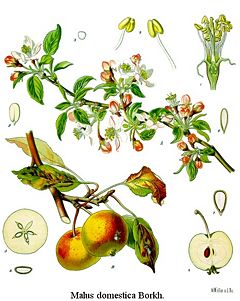 Apple tree (Malus domestica) | ||||||||||||||||
| Scientific classification | ||||||||||||||||
| ||||||||||||||||
| Binomial name | ||||||||||||||||
| Malus domestica Borkh. |
The apple is a genus (Malus) of about 30–35 species of small deciduous trees or shrubs in the flowering plant family Rosaceae. The term also refers to the fruit of these trees, and in particular the fruit of the species Malus domestica, the domesticated orchard or table apple. This is one of the most widely cultivated tree fruits. The other species are generally known as "wild apples," "crab apples," "crabapples," or "crabs," this name being derived from their generally small and sour, unpalatable fruit. The genus is native to the temperate zone of the Northern Hemisphere, in Europe, Asia, and North America.
Malus species and their fruit offer many nutritional, ecological, and aesthetic values—providing health benefits for humans, a home for many species, and pleasures of taste and sight. Through their harmonious relationship with pollinating insects, apple trees can produce fruit and reproduce, while providing nectar in exchange. The domestic apple also serves symbolic value in works of art and various legends and traditions. In the Christian tradition, it is the apple that is often depicted as the forbidden fruit at the center of the Genesis account of the fall of Adam and Eve.
Malus species, including domestic apples, hybridize freely. The trees are used as food plants by the larvae of a large number of Lepidoptera species. The fruit is a globose pome, varying in size from 1–4 cm diameter in most of the wild species, to 6 cm in M. pumila, 8 cm in M. sieversii, and even larger in cultivated orchard apples. The center of the fruit contains five carpels arranged star-like, each containing one to two (rarely three) seeds.
One species, Malus trilobata, from southwest Asia, has three- to seven-lobed leaves (superficially resembling a maple leaf) and with several structural differences in the fruit; it is often treated in a genus of its own, as Eriolobus trilobatus.
Malus domestica, the domesticated orchard apple, is a small tree, generally reaching 5–12 meters in height, with a broad, often densely twiggy crown. Apples require cross-pollination between individuals by insects (typically bees, which freely visit the flowers for both nectar and pollen).
Origin of name
The word apple comes from the Old English word aeppel, which in turn has recognizable cognates in a number of the northern branches of the Indo-European language family. The prevailing theory is that "apple" may be one of the most ancient Indo-European words (*abl-) to come down to English in a recognizable form. The scientific name Malus, on the other hand, comes from the Latin word for apple, and ultimately from the archaic Greek mālon (mēlon in later dialects). The legendary place name Avalon is thought to come from a Celtic evolution of the same root as the English "apple"; the name of the town of Avellino, near Naples in Italy is likewise thought to come from the same root via the Italic languages.
Malus domestica
The leaves of domestic apple trees are alternately arranged, simple oval with an acute tip and serrated margin, slightly downy below, 5–12 cm long and 3–6 cm broad on a 2–5 cm petiole.
The flowers, produced in spring with the leaves, are usually white, often tinged with pink at first. The flowers are about 2.5–3.5 cm diameter, with five petals, and with usually red stamens that produce copious pollen, and an inferior ovary. Flowering occurs in the spring after 50–80 growing degree days. All flowers are self-sterile, and self-pollination is impossible, making pollinating insects essential. The honeybee is the most effective pollinator of domestic apples.
Botanical origins
The wild ancestor of Malus domestica is Malus sieversii. It has no common name in English, but is known where it is native as "alma"; in fact, one major city in the region where it is thought to originate is called Alma-Ata, or "father of the apples." This tree is still found wild in the mountains of Central Asia in southern Kazakhstan, Kyrgyzstan, Tajikistan, and Xinjiang, China.
For many years, there was a debate about whether M. domestica evolved from chance hybridization among various wild species. Recent DNA analysis by Barrie Juniper and others has indicated, however, that the hybridization theory is probably false. Instead, it appears that a single species, which is still growing in the Ili Valley on the northern slopes of the Tien Shan mountains at the border of northwest China and the former Soviet Republic of Kazakhstan, is the likely progenitor of the apples people eat today. Leaves taken from trees in this area were analyzed for DNA composition, which showed them all to belong to the species Malus sieversii, with some genetic sequences common to M. domestica.
Other species that were previously thought to have made contributions to the genome of the domestic apples are Malus baccata and Malus sylvestris, but there is no hard evidence for this in older apple cultivars. These and other Malus species have been used in program to develop apples suitable for growing in climates unsuitable for M. domestica, mainly for increased cold tolerance.
The apple tree was probably the earliest tree to be cultivated.
Apple cultivars
There are more than 7,500 known cultivars of apples. (A cultivar is similar to "variety"; it is a named group of cultivated plants.) Different cultivars are available for temperate and subtropical climates. Apples do not flower in tropical climates because they have a chilling requirement.
Commercially-popular apple cultivars are soft, but crisp. Other desired qualities in modern commercial apple breeding are a colorful skin, absence of russeting, ease of shipping, lengthy storage ability, high yields, disease resistance, typical "Red Delicious" apple shape, long stem (to allow pesticides to penetrate the top of the fruit), and popular flavor.
Old cultivars are often oddly shaped, russeted, and have a variety of textures and colors. Many of them have excellent flavor (arguably better than more commercial apples), but may have other problems that make them commercially unviable, such as low yield, liability to disease, or poor tolerance for storage or transport. A few old cultivars are still produced on a large scale, but many have been kept alive by home gardeners and farmers that sell directly to local markets. Many unusual and locally important cultivars with their own unique taste and appearance are out there to discover; apple conservation campaigns have sprung up around the world to preserve such local cultivars from extinction.
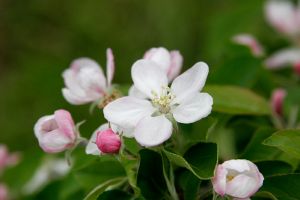
Although most cultivars are bred for eating fresh (dessert apples), some are cultivated specifically for cooking (cooking apples) or producing cider. Cider apples are typically too tart and astringent to eat fresh, but they give the beverage a rich flavor that dessert apples cannot.
Modern apples are generally sweeter than older cultivars. Most North Americans and Europeans favor sweet, subacid apples, but tart apples have a strong, but reduced following. Extremely sweet apples with barely any acid flavor are popular in Asia and especially India.
Tastes in apples vary from one person to another and have changed over time. As an example, the U.S. state of Washington made its reputation for apple growing on Red Delicious. In recent years, many apple connoisseurs have come to regard the Red Delicious as inferior to cultivars such as Fuji and Gala due to its merely mild flavor and insufficiently firm texture.
Commerce and uses
Domestic apples have remained an important food in all cooler climates. To a greater degree than other tree fruit, except possibly citrus, apples store for months while still retaining much of their nutritive value. Winter apples, picked in late autumn and stored just above freezing, have been an important food in Asia and Europe for millennia, as well as in Argentina and in the United States since the arrival of Europeans.
In 2002, 45 million tons of apples were grown worldwide, with a value of about 10 billion U.S. dollars. China produced almost half of this total. Argentina is the second-leading producer, with more than 15 percent of the world production. The United States is third in production, accounting for 7.5 percent of world production. Turkey is also a leading producer. France, Italy, South Africa, and Chile are among the leading apple exporters.
In the United States, more than 60 percent of all the apples sold commercially are grown in Washington State. Imported apples from New Zealand and other more temperate areas are increasing each year and competing with U.S. production.
Apples can be canned, juiced, and optionally fermented to produce apple juice, cider, vinegar, and pectin. Distilled apple cider produces the spirits applejack and Calvados. Apple wine can also be made. Apples make a popular lunchbox fruit as well.
Apples are an important ingredient in many winter desserts, for example apple pie, apple crumble, apple crisp, and apple cake. They are often eaten baked or stewed, and they can also be dried and eaten or re-constituted (soaked in water, alcohol, or some other liquid) for later use. Puréed apples are generally known as apple sauce. Apples are also made into apple butter and apple jelly. They are used cooked in meat dishes, too.
In the United Kingdom, a toffee apple is a traditional confection made by coating an apple in hot toffee and allowing it to cool. Similar treats in the United States are candy apples (coated in a hard shell of crystallized sugar syrup), and caramel apples, coated with cooled caramel.
Apples are eaten with honey at the Jewish New Year of Rosh Hashanah to symbolize a sweet new year.
The fruit of the other species, wild apples or crabapples, is not an important crop, being extremely sour and (in some species) woody, and is rarely eaten raw for this reason. However if crabapples are stewed and the pulp is carefully strained and mixed with an equal volume of sugar then boiled, their juice can be made into a tasty ruby-colored crabapple jelly. A small percentage of crab apples in cider make a more interesting flavor.
Crabapples are widely grown as ornamental trees, grown for their beautiful flowers or fruit, with numerous cultivars selected for these qualities and for resistance to disease.
Health benefits
Apples have long been considered healthy, as indicated by the proverb "an apple a day keeps the doctor away." Research suggests that apples may reduce the risk of colon cancer, prostate cancer, and lung cancer. Like many fruits, apples contain Vitamin C as well as a host of other antioxidant compounds, which may explain some of the reduced risk of cancer (with the free radical elimination reducing cancer risk by counteracting DNA damage). The fiber in the fruit (while less than most other fruits) helps keep the bowels healthy, which may be a factor in the reduced risk of colon cancer. They may also help with heart disease and controlling cholesterol, since apples lack cholesterol and have fiber, which reduces cholesterol by preventing re-absorption. They are bulky for their caloric content, like most fruits and vegetables, and may help with weight loss.
A group of chemicals in apples could protect the brain from the type of damage that triggers such neurodegenerative diseases as Alzheimer's and Parkinson’s. Chang Y. Lee (2003) of Cornell University found that the apple phenolics, which are naturally occurring antioxidants found in fresh apples, can protect nerve cells from neurotoxicity induced by oxidative stress. The researchers used Red Delicious apples grown in New York State to provide the extracts to study the effects of phytochemicals. Lee reported that all domestic apples are high in the critical phytonutrients (usually used to refer to compounds found in plants that are not required for normal functioning of the body, but that nonetheless have a beneficial effect on health or an active role in the amelioration of disease). It was further reported that the amount of phenolic compounds in the apple's flesh and skin vary from year to year, season to season, and from growing region to growing region (Heo et al. 2004). The predominant phenolic phytochemicals in apples are quercetin, epicatechin, and procyanidin B2 (Lee et al. 2003).
Apples are historically known for producing apple milk. A derivative of apple curd, apple milk is widely used throughout Tibet.
Growing apples
Apple breeding
Like most perennial fruits, apples are ordinarily propagated asexually by grafting, the method of plant propagation widely used in horticulture, where the tissues of one plant are encouraged to fuse with those of another.
Seedling apples are different from their parents, sometimes radically. Most new apple cultivars originate as seedlings, which either arise by chance or are bred by deliberately crossing cultivars with promising characteristics. The words "seedling," "pippin," and "kernel" in the name of an apple cultivar suggest that it originated as a seedling.
Apples can also form bud sports (mutations on a single branch). Some bud sports turn out to be improved strains of the parent cultivar. Some differ sufficiently from the parent tree to be considered new cultivars.
Some breeders have crossed ordinary apples with crabapples or unusually hardy apples in order to produce hardier cultivars. For example, the Excelsior Experiment Station of the University of Minnesota has, since the 1930s, introduced a steady progression of important hardy apples that are widely grown, both commercially and by backyard orchardists, throughout Minnesota and Wisconsin. Its most important introductions have included Haralson (which is the most widely cultivated apple in Minnesota), Wealthy, Honeygold, and Honeycrisp. The sweetness and texture of Honeycrisps have been so popular with consumers that Minnesota orchards have been cutting down their established, productive trees to make room for it, a previously unheard of practice.
Starting an orchard
Apple orchards are established by planting two- to four-year-old trees. These small trees are usually purchased from a nursery, where they are produced by grafting or budding. First, a rootstock is produced either as a seedling or cloned using tissue culture or layering. A rootstock is a stump that already has an established, healthy root system, used for grafting a twig from another tree. The tree part, usually a small section of branch, being grafted onto the rootstock is usually called the scion. This is allowed to grow for a year. The scion is obtained from a mature apple tree of the desired cultivar. The upper stem and branches of the rootstock are cut away and replaced with the scion. In time, the two sections grow together and produce a healthy tree.
Rootstocks affect the ultimate size of the tree. While many rootstocks are available to commercial growers, those sold to homeowners who want just a few trees are usually one of two cultivars: a standard seedling rootstock that gives a full-size tree; or a semi-dwarf rootstock that produces a somewhat smaller tree. Dwarf rootstocks are generally more susceptible to damage from wind and cold. Full dwarf trees are often supported by posts or trellises and planted in high density orchards that are much simpler to culture and greatly increase productivity per unit of land.
Some trees are produced with a dwarfing "interstem" between a standard rootstock and the tree, resulting in two grafts.
After the small tree is planted in the orchard, it must grow for 3 to 5 years (semi-dwarf) or 4 to 10 years (standard trees) before it will bear sizeable amounts of fruit. Good training of limbs and careful nipping of buds growing in the wrong places, are extremely important during this time in order to build a good scaffold that will later support a fruit load.
Location
Apples are relatively indifferent to soil conditions and will grow in a wide range of pH values and fertility levels. They do require some protection from the wind and should not be planted in low areas that are prone to late spring frosts. Apples do require good drainage, and heavy soils or flat land should be tilled to make certain that the root systems are never in saturated soil.
Pollination
Apples are self-incompatible and must be cross-pollinated to develop fruit. Pollination management is an important component of apple culture. Before planting, it is important to arrange for pollenizers—cultivars of apple or crabapple that provide plentiful, viable, and compatible pollen. Orchard blocks may alternate rows of compatible cultivars, or may have periodic crabapple trees, or grafted-on limbs of crab apple. Some cultivars produce very little pollen, or the pollen is sterile, so these are not good pollenizers. Quality nurseries have pollenizer compatibility lists.
Growers with old orchard blocks of single cultivars sometimes provide bouquets of crab apple blossoms in drums or pails in the orchard for pollenizers. Home growers with a single tree and no other cultivars in the neighborhood can do the same on a smaller scale.
During the flowering each season, apple growers usually provide pollinators to carry the pollen. Honeybee hives are most commonly used, and arrangements may be made with a commercial beekeeper who supplies hives for a fee. Orchard mason bees (Megachilidae) are also used as supplemental pollinators in commercial orchards. Home growers may find these more acceptable in suburban locations because they do not sting. Some wild bees such as carpenter bees and other solitary bees may help. Bumble bee queens are sometimes present in orchards, but not usually in enough quantity to be significant pollinators.
Symptoms of inadequate pollination are excessive fruit drop (when marble sized), small and misshapen apples, slowness to ripen, and low seed count. Well pollinated apples are of the best quality, and will have 7 to 10 seeds. Apples having less than 3 seeds will usually not mature and will drop from the trees in the early summer. Inadequate pollination can result from either a lack of pollinators or pollenizers, or from poor pollinating weather at flowering time. It generally requires multiple bee visits to deliver sufficient grains of pollen to accomplish complete pollination.
A common problem is a late frost that destroys the delicate outer structures of the flower. It is best to plant apples on a slope for air drainage, but not on a south-facing slope (in the Northern Hemisphere) as this will encourage early flowering and increase susceptibility to frost. If the frost is not too severe, the tree can be wetted with water spray before the morning sun hits the flowers, and it may save them. Frost damage can be evaluated 24 hours after the frost. If the pistil has turned black, the flower is ruined and will not produce fruit.
Growing apples near a large body of water can give an advantage by slowing spring warm up, which retards flowering until frost is less likely. In some areas of the United States, such as the eastern shore of Lake Michigan, the southern shore of Lake Ontario, and around some smaller lakes, this cooling effect of water, combined with good, well-drained soils, has made apple growing concentrations possible. However, the cool, humid spring weather in such locations can also increase problems with fungal diseases, notably apple scab; many of the most important apple-growing regions (e.g. northern China, central Turkey, and eastern Washington in the U.S.) have climates more like the species' native region, well away from the sea or any lakes, with cold winters leading to a short, but warm spring with low risk of frost.
Home growers may not have a body of water to help, but can utilize north slopes or other geographical features to retard spring flowering. Apples (or any fruit) planted on a south facing slope in the Northern Hemisphere (or north facing in the Southern Hemisphere), will flower early and be particularly vulnerable to spring frost.
Thinning
Apples are prone to biennial bearing. If the fruit is not thinned when the tree carries a large crop, it may produce very little flowers the following year. Good thinning helps even out the cycle, so that a reasonable crop can be grown every year.
Commercial orchardists practice chemical thinning, which is not practical for home fruit. Apples bear in groups of five (or more rarely six) blossoms. The first blossom to open is called the king bloom. It will produce the best possible apple of the five. If it sets, it tends to suppress setting of the other blossoms, which, if they set anyway, should be removed. The next three blossoms tend to bloom and set simultaneously, therefore there is no dominance. All but one of these should be thinned for best quality. If the final blossom is the only one that sets, the crop will not be as good, but it will help reduce excessive woody growth (suckering) that usually happens when there is no crop.
Maturation and harvest
Cultivars vary in their yield and the ultimate size of the tree, even when grown on the same rootstock. Some cultivars, if left unpruned, will grow very large, which allows them to bear a great deal more fruit, but makes harvest very difficult. Mature trees typically bear 40 to 200 kg of apples each year, though productivity can be close to zero in poor years. Apples are harvested using three-point ladders that are designed to fit amongst the branches. Dwarf trees will bear about 10 to 80 kg of fruit per year.
Pests and diseases
Apple trees are susceptible to a number of fungal and bacterial diseases and insect pests. Nearly all commercial orchards pursue an aggressive program of chemical sprays to maintain high fruit quality, tree health, and high yields. A trend in orchard management is the use of Integrated Pest Management (IPM), which reduces needless spraying when pests are not present or are more likely to be controlled by natural predators.
Spraying for insect pests must never be done during flowering because it kills pollinators. Nor should bee-attractive plants be allowed to establish in the orchard floor if insecticides are used. White clover is a component of many grass seed mixes, and many bees are poisoned by insecticides while visiting the flowers on the orchard floor after a spraying.
Among the most serious disease problems are fireblight, a bacterial disease; and Gymnosporangium rust, apple scab, and black spot, three fungal diseases.
The plum curculio is the most serious insect pest. Others include apple maggot and codling moth.
Apples are difficult to grow organically, though a few orchards have done so with commercial success, using disease-resistant cultivars and the very best cultural controls. The latest tool in the organic repertoire is to spray a light coating of kaolin clay, which forms a physical barrier to some pests, and also helps prevent apple sun scald.
Cultural aspects
Apples as symbols
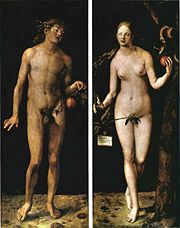
A classic depiction of the biblical tale showcasing the apple as a symbol of sin.
Albrecht Dürer, 1507; Oil on panel; 209 x 81 cm (per panel); Museo Nacional del Prado, Madrid..[1]
Apples appear in some religious traditions, in particular Christianity, where it is often depicted as a mystical and forbidden fruit. This tradition is reflected in the book of Genesis. Though the forbidden fruit in that account is not identified, popular European Christian tradition has held that it was an apple that Eve coaxed Adam to share with her. As a result, in the story of Adam and Eve, the apple became a symbol for temptation, the fall of man into sin, and of sin itself. The apple is also sometimes symbolically equated with illicit sex. In Latin, the words for "apple" and for "evil" are identical (malum). This may be the reason that the apple was interpreted as the biblical “forbidden fruit.” The larynx in the human throat has been called Adam's apple because of a notion that it was caused by the forbidden fruit sticking in the throat of Adam.
This notion of the apple as a symbol of sin is reflected in artistic renderings of the fall from Eden. When held in Adam's hand, the apple symbolizes sin. However, when Christ is portrayed holding an apple, he represents the Second Adam, who brings life. This also reflects the evolution of the symbol in Christianity. In the Old Testament, the apple was significant of the fall of man; in the New Testament it is an emblem of the redemption from that fall, and as such is also represented in pictures of the Madonna and Infant Jesus.
There is one instance in the Old Testament where the apple is used in a more favorable light. In Proverbs 25:11, the verse states, “a word fitly spoken is like apples of gold in settings of silver.” In this instance, the apple is being used as a symbol for beauty.
Apples in mythology
As symbolic of love and sexuality in art, the apple is often an attribute associated with Venus who is shown holding it.
In Greek mythology, the hero Heracles, as a part of his Twelve Labours, was required to travel to the Garden of the Hesperides and pick the golden apples off the Tree of Life growing at its center.
The Greek goddess of discord, Eris, became disgruntled after she was excluded from the wedding of Peleus and Thetis. In retaliation, she tossed a golden apple inscribed Kallisti ("For the most beautiful one"), into the wedding party. Three goddesses claimed the apple: Hera, Athena, and Aphrodite. Paris of Troy was appointed to select the recipient. After being bribed by both Hera and Athena, Aphrodite tempted him with the most beautiful woman in the world, Helen of Sparta. He awarded the apple to Aphrodite, thus indirectly causing the Trojan War.
Atalanta, also of Greek mythology, raced all her suitors in an attempt to avoid marriage. She outran all but Hippomenes, who defeated her by cunning, not speed. Hippomenes knew that he could not win in a fair race, so he used three golden apples to distract Atalanta. It took all three apples and all of his speed, but Hippomenes was finally successful, winning the race and Atalanta's hand.
In Norse mythology, the goddess Iðunn was the appointed keeper of apples that kept the Æsir young forever. Iðunn was abducted by Þjazi the giant, who used Loki to lure Iðunn and her apples out of Ásgarðr. The Æsir began to age without Iðunn’s apples, so they coerced Loki into rescuing her. After borrowing Freyja’s falcon skin, Loki liberated Iðunn from Þjazi by transforming her into a nut for the flight back. Þjazi gave chase in the form of an eagle, where upon reaching Ásgarðr he was set aflame by a bonfire lit by the Æsir. With the return of Iðunn’s apples, the Æsir regained their lost youth.
Celtic mythology includes a story about Conle who receives an apple that feeds him for a year but also gives him an irresistible desire for Fairyland.
Legends, folklore, and traditions
- Swiss folklore holds that William Tell courageously shot an apple from his son's head with his crossbow, defying a tyrannical ruler and bringing freedom to his people.
- Irish folklore claims that if an apple is peeled into one continuous ribbon and thrown behind a woman's shoulder, it will land in the shape of the future husband's initials.
- Danish folklore says that apples wither around adulterers.
- According to a popular legend, Isaac Newton, upon witnessing an apple fall from its tree, was inspired to conclude that a similar “universal gravitation” attracted the Moon toward the Earth.
- In the European fairy tale Snow White, the princess is killed, or sunk into a kind of coma with the appearance of death, by choking on, or falling ill, from a poisoned apple given to her by her stepmother.
- In Arthurian legend, the mythical isle of Avalon’s name is believed to mean "isle of apples."
- In the United States, Denmark, and Sweden, an apple (polished) is a traditional gift for a teacher. This stemmed from the fact that teachers during the sixteenth to eighteenth centuries were poorly paid, so parents would compensate the teacher by providing food. As apples were a very common crop, teachers would often be given baskets of apples by students. As wages increased, the quantity of apples was toned down to a single fruit.
- The Apple Wassail is a traditional form of wassailing practiced in cider orchards of southwest England during the winter. The ceremony is said to "bless" the apple trees to produce a good crop in the forthcoming season.
ReferencesISBN links support NWE through referral fees
- Ferree, D. C., and I. Warringtion, eds. 2003. Apples: Botany, Production, and Uses. CABI Publishing International. ISBN 0851995926
- Heo, H. J., D. O. Kim, S. J. Choi, D. H. S. Shin, and C. Y. Lee. 2004. Apple phenolics protect in vitro oxidative stress induced neuronal cell death. Journal of Food Science 69(9):357–361.
- Lee, K. W., Y. J. Kim, D. O. Kim, H. J. Lee, and C. Y. Lee. 2003. Major phenolics in apple and their contribution to the total antioxidant capacity. Journal of Agricultural Food Chemistry 51(22):16–20. PMID 14558772
Credits
New World Encyclopedia writers and editors rewrote and completed the Wikipedia article in accordance with New World Encyclopedia standards. This article abides by terms of the Creative Commons CC-by-sa 3.0 License (CC-by-sa), which may be used and disseminated with proper attribution. Credit is due under the terms of this license that can reference both the New World Encyclopedia contributors and the selfless volunteer contributors of the Wikimedia Foundation. To cite this article click here for a list of acceptable citing formats.The history of earlier contributions by wikipedians is accessible to researchers here:
The history of this article since it was imported to New World Encyclopedia:
Note: Some restrictions may apply to use of individual images which are separately licensed.
